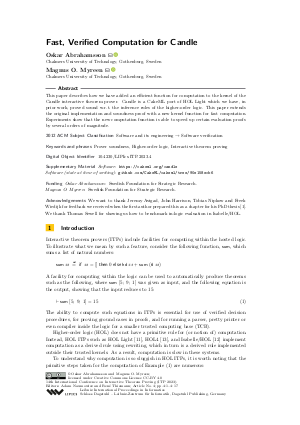@InProceedings{abrahamsson_et_al:LIPIcs.ITP.2023.4,
author = {Abrahamsson, Oskar and Myreen, Magnus O.},
title = {{Fast, Verified Computation for Candle}},
booktitle = {14th International Conference on Interactive Theorem Proving (ITP 2023)},
pages = {4:1--4:17},
series = {Leibniz International Proceedings in Informatics (LIPIcs)},
ISBN = {978-3-95977-284-6},
ISSN = {1868-8969},
year = {2023},
volume = {268},
editor = {Naumowicz, Adam and Thiemann, Ren\'{e}},
publisher = {Schloss Dagstuhl -- Leibniz-Zentrum f{\"u}r Informatik},
address = {Dagstuhl, Germany},
URL = {https://drops.dagstuhl.de/entities/document/10.4230/LIPIcs.ITP.2023.4},
URN = {urn:nbn:de:0030-drops-183797},
doi = {10.4230/LIPIcs.ITP.2023.4},
annote = {Keywords: Prover soundness, Higher-order logic, Interactive theorem proving}
}

 Creative Commons Attribution 4.0 International license
Creative Commons Attribution 4.0 International license


